What surfaces can I tile?
Tiles can be applied to many stable surfaces (often referred to as substrates), once the right preparation has taken place. Tiles are rigid and will not bend or flex. So in order to stop them from fracturing or becoming loose the surface needs to be firm and secure.
The following surfaces can be tiled, however, the correct preparation is required.
Floor Tiling
Floor Boards
We do not recommend fitting directly to floor boards due to the variable movement, both deflection and lateral movement. Floor boards need to be overlaid with 6mm No More Ply cement backer boards following the No More Ply fixing guide. Or overlaid with 15mm marine grade plywood (WPB Board) fixed every 300mm. Remember to ensure the floorboards are secured as well as possible prior to commencing. Either an S1 rapid set flexible adhesive can be to fix the tiles, for faster drying times, or an S1 standard set flexible adhesive for a slower setting time.Chipboard/OSB
Due to the instability and high wax content of chipboard it is not recommended to tile directly onto these types of boarded floors. The chipboard will need to be overlaid with 6mm no more ply boards to stabilise the floor, this should be fitted in accordance with the no more ply guidance and fitting instructions. Tiles can then be installed using an S1 rapid set flexible adhesive or an S1 standard set flexible adhesive for a slower setting time.
Plywood
We recommend overlaying 6mm no more ply over plywood to stabilise the floor and provide a water resistant surface. You can replace the ply with No More Ply 22mm tile backer boards. However, when tiling direct to plywood it should conform to BS EN 636 Class 3 (exterior grade) be 15mm thick and screwed down every 300mm. It is important to ensure that the floor is well supported and free from deflection. This then needs to be primed with an acrylic primer before tiling.
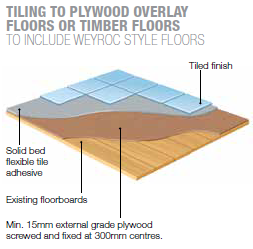
Existing Tiling
Make sure any loose tiles have been removed and the surface has been cleaned is free from grease and dirt. The existing tiling must be sound and secure. The surface will need to be primed with NP Keycoat or Primer Grip 360 before tiling. Either an S1 rapid set flexible adhesive can be to fix the tiles, for faster drying times, or an S1 standard set flexible adhesive for a slower setting time.
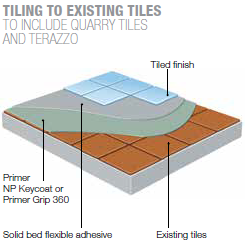
Concrete floors or sand and cement screed
A concrete base (if tiling direct) should be a minimum of 6 weeks old. Remove any laitance and vacuum along with any dust. Prime with 2 coats of acrylic primer. It is good practice to prime the second coat at a 90 degree angle to the first to ensure full surface coverage. When tiling onto a cement based screed the code of practice recommends that the screed be at least 4 weeks old. However, this can vary depending on ambient room temperature, thickness and type of screed. A moisture test should be taken to ensure that it contains a moisture content of no more than 0.5% before tiling. When tiling on anhydrite screed a layer of the surface will need to be sanded down and then primed twice, for further guidance, speak to one of our customer support team on 01473 805 959.
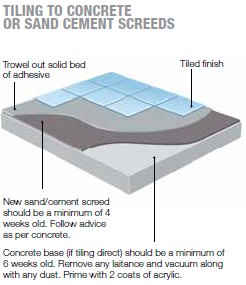
Wall Tiling
Plaster
This will need to be primed with an acrylic primer when using a powder adhesive. Plaster can only hold 20kgm², this must include 2-4kg for adhesive and grout. Plaster needs to be a minimum 3 weeks old and cannot be base plaster. Plaster must be fully dry before tiling commences.
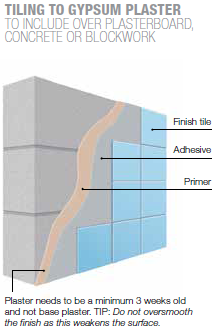
Plasterboard
Plasterboard must be securely fixed and rigid with no protruding fixings. The plasterboard must be fixed in accordance to the manufacturer's recommendations. We do not recommend tiling onto plasterboard in wet areas such as bathrooms or wetrooms. Plasterboard will deteriorate when coming into contact with moisture. Plasterboard will only hold 32kgm² so we recommend replacing the plasterboard with 12mm No More Ply. This will give you a sound water resistant surface that can hold a weight of 65kgm².
Backerboards
There are many of these on the market, we recommend the No More Ply board as it has a high strength, is very easy to install and provides a water resistant stable surface to tile onto.
Existing Tiling
Make sure any loose tiles have been removed and the surface has been cleaned and free from grease and dirt before fixing new tiles. The surface will need to be primed with NP Keycoat or Primer Grip 360 before tiling. Due to the non porous nature of this background its best practice to leave the tiling for 48 hrs before grouting to give the adhesive sufficient time to dry. Either an S1 rapid set flexible adhesive can be used to fix the tiles or an S1 standard set flexible adhesive can be used for a slower setting time.
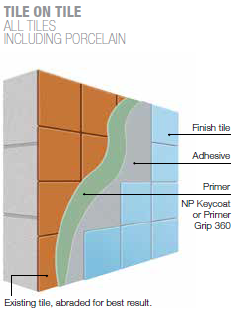
We do not recommend that you tile onto the following surfaces:
If you have any further questions please call out customer support team 01473 805 959, or send us an e mail [email protected] and one of our team will get back to you soon after.



































